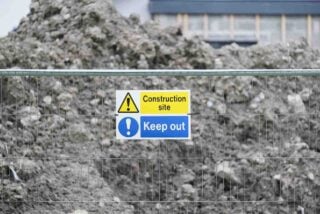
The number of asbestos abatement projects has grown during the COVID-19 pandemic. To help prevent exposure, many hotels, schools, restaurants and other establishments closed for months. Business owners used this time to conduct renovations, demolitions and expansions.
Despite the growth in abatement projects, research indicates a drop in asbestos training. Abatement professionals must complete training to safely identify, handle and remove asbestos. Lack of training can put many people at risk for asbestos diseases.
Asbestos Abatement During COVID-19
Concerns for public safety resulted in mandatory closures. Schools, hotels, restaurants and stores closed to protect Americans. Public officials and business owners used this downtime for construction. As a result, asbestos contractors have received more work in recent months.
Contractors complete asbestos removal when buildings are empty to prevent exposure.
During construction, workers can disturb asbestos-containing materials. Personal protective equipment (PPE) can help protect workers from exposure. There are also additional safety measures, such as wetting down asbestos materials that may help prevent exposure.
Without proper safety measures, individuals on or near the worksite can then inhale or ingest the fibers. This may include untrained workers or those without the proper PPE. Individuals living near an asbestos worksite may also risk exposure. If exposed, individuals could develop mesothelioma, asbestosis or lung cancer.
Accelerated Asbestos Abatement in Schools
Asbestos professionals are often contracted to complete work in schools during the summer when school isn’t in session. This helps protect teachers and students from exposure.
Although asbestos has been regulated in building products since the 1980s, many schools were constructed before these regulations. Asbestos in older schools continues to be a growing concern. As a result, districts have prioritized asbestos removal to protect students and teachers.
Many school districts closed in the spring to help stop the spread of the coronavirus. As a result, school officials started asbestos-abatement projects early. Districts released public announcements of their plans to take care of asbestos concerns before students returned to school.
Efforts to Meet New Environmental Safety Standards
Some cities are accelerating asbestos-abatement projects during the pandemic to meet new safety standards.
For example, New York City recently passed the Climate Mobilization Act. The city aims to reduce greenhouse gas emissions from buildings by 40% (by 2030). Abatement professionals are replacing insulation, windows and other materials to improve energy efficiency.
As a result, abatement work has spiked for New York City contractors during the pandemic.
Safety Measures for Abatement Professionals During COVID-19
To ensure safety during the pandemic, asbestos workers have additional protocols. For example, NYC officials published local requirements for abatement professionals working during COVID-19.
Before each work shift, supervisors may require asbestos-abatement workers to:
- Complete health screenings
- Receive a temperature check
- Adhere to on-site protection plans
- Follow social-distancing requirements
- Wear appropriate face coverings
Other safety measures include immediately reporting a positive COVID-19 test result and to avoid gathering in groups with coworkers.
Workers should discuss coronavirus safety measures with their supervisor. Regulations vary from state to state according to incidence rates across the country.
Alarming Drop in Asbestos Training
Research indicates a large decline in asbestos training. A UK study demonstrated a 66% drop in asbestos training compared to before the pandemic.
On average, 18,000 workers completed asbestos training each month before COVID-19. During the pandemic (March – August), the average has dropped to 6,000 workers a month.*
*This data is specific to the UK construction industry. It is also specific to training under the UK Asbestos Training Association (UKATA).
Asbestos Training in the United States During COVID-19
The United States has also demonstrated a shift in asbestos-abatement training.
COVID-19 affected the asbestos-abatement industry in the United States by:
- Extending certification deadlines
- Reducing prices for refresher courses
- Delaying the processing of licenses and certifications
- Delaying and canceling training courses
- Transitioning in-person courses to virtual trainings
Instructors canceled in-person training to ensure participant safety. The Centers for Disease Control and Prevention (CDC) has released several safety recommendations. It advises against close contact with others and recommends maintaining a distance of six feet apart.
Additionally, many training courses are now virtual. This allows contractors to achieve their certification while at home.
Proper training is crucial to protect asbestos workers from exposure. Asbestos-abatement professionals risk mesothelioma, asbestosis and other illnesses if exposed to asbestos fibers. Furthermore, individuals with asbestos illnesses could be more susceptible to complications from COVID-19.




